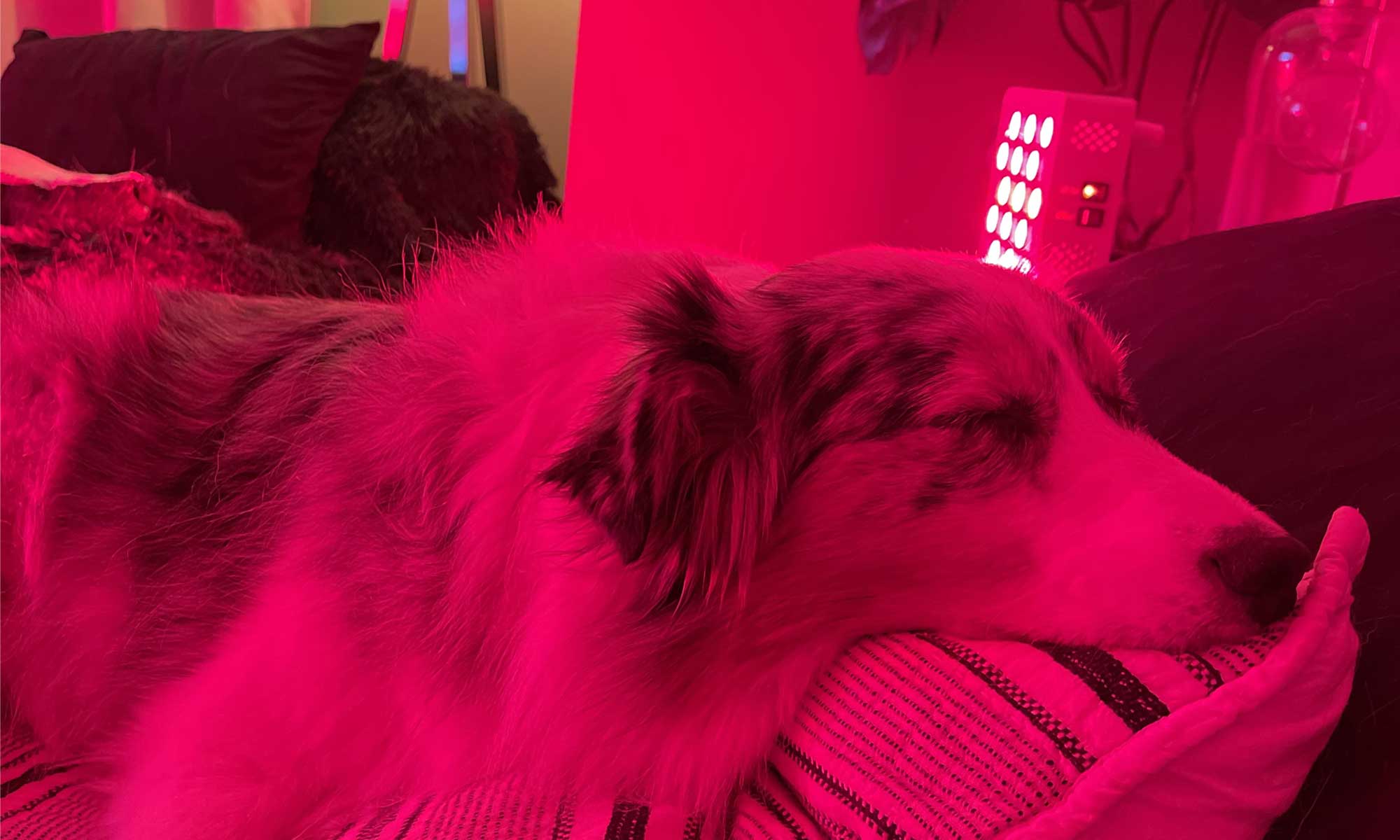Red light therapy and near-infrared therapy have gained recognition for their therapeutic benefits in human healthcare, but their applications extend beyond humans to include veterinary medicine. Red light therapy (RLT) and near-infrared therapy (NIRT) can offer a safe, non-invasive, and effective means of addressing various health conditions in pets, ranging from musculoskeletal disorders to dermatological issues and beyond.
Understanding Red Light Therapy and Near-Infrared Therapy
Before delving into their applications in veterinary medicine, it's essential to understand the principles underlying red light therapy and near-infrared therapy.
Red Light Therapy (RLT): RLT utilizes specific wavelengths of red light, typically in the range of 600 to 700 nanometers, to penetrate superficial tissues and stimulate cellular processes. When absorbed by cells, red light promotes mitochondrial activity, leading to increased production of adenosine triphosphate (ATP), the energy currency of cells. This enhanced cellular metabolism results in various therapeutic effects, including accelerated tissue repair, reduced inflammation, and pain relief.
Near-Infrared Therapy (NIRT): NIRT involves the use of near-infrared light, with wavelengths ranging from 700 to 1400 nanometers, to penetrate deeper into tissues and exert biological effects. Similar to RLT, NIRT enhances mitochondrial function and cellular metabolism, but its deeper tissue penetration allows it to target muscles, joints, and internal organs more effectively. NIRT is particularly beneficial for conditions requiring deeper tissue penetration and systemic effects, such as musculoskeletal injuries, circulatory disorders, and immune modulation.
Applications in Veterinary Medicine
1. Pain Management:
RLT and NIRT can be invaluable tools for managing pain in pets, whether it's due to acute injuries, chronic conditions like arthritis, or postoperative discomfort. By reducing inflammation, modulating pain signaling pathways, and promoting tissue repair, both modalities offer effective pain relief without the side effects associated with pharmaceutical medications. Whether applied locally to target specific areas of pain or administered systemically for broader effects, RLT and NIRT can improve mobility, enhance quality of life, and reduce reliance on conventional pain medications in pets.
2. Musculoskeletal Conditions:
Pets, like humans, can suffer from a range of musculoskeletal disorders, including muscle strains, ligament injuries, and joint degeneration. RLT and NIRT can aid in the management of these conditions by promoting tissue repair, reducing inflammation, and alleviating muscle tension. Whether used alone or as part of a comprehensive rehabilitation program, these modalities can enhance recovery, restore mobility, and prevent secondary complications in pets with musculoskeletal injuries or orthopedic surgeries.
3. Dermatological Issues:
Dermatological conditions are common in pets and can cause discomfort, itching, and skin lesions. RLT has shown promise in treating various dermatological issues in pets, including wound healing, hot spots, allergic dermatitis, and inflammatory skin conditions. By promoting collagen synthesis, accelerating wound closure, and modulating immune responses, RLT can facilitate faster resolution of skin lesions, reduce itching and inflammation, and promote healthier skin and coat in pets. Additionally, NIRT's deeper tissue penetration makes it suitable for addressing underlying inflammatory processes and promoting systemic healing in pets with chronic or widespread skin conditions.
4. Postoperative Recovery:
Following surgical procedures, pets may experience pain, swelling, and impaired mobility during the recovery period. RLT and NIRT can play a crucial role in supporting postoperative healing and rehabilitation by reducing inflammation, promoting tissue regeneration, and enhancing circulation. When applied preoperatively or postoperatively, these modalities can minimize postoperative complications, accelerate wound healing, and facilitate faster recovery, allowing pets to return to normal activities sooner with reduced discomfort and risk of complications.
5. Age-Related Conditions:
As pets age, they may develop age-related conditions such as osteoarthritis, cognitive dysfunction, and metabolic disorders. RLT and NIRT offer therapeutic benefits for managing these conditions by promoting joint health, cognitive function, and metabolic balance in senior pets. By alleviating pain and stiffness, improving circulation, and supporting cellular function, these modalities can enhance mobility, cognitive clarity, and overall vitality in aging pets, improving their quality of life and extending their active years with their families.
6. Stress and Anxiety:
Pets may experience stress and anxiety due to various factors, including changes in environment, separation from caregivers, or fear of loud noises. RLT and NIRT can help alleviate stress and anxiety in pets by promoting relaxation, reducing cortisol levels, and modulating neurotransmitter activity. Whether used as part of a behavior modification program or to support pets during stressful events, such as veterinary visits or travel, these modalities can help calm anxious pets and improve their overall well-being.
Considerations for Safe and Effective Use
While RLT and NIRT offer numerous benefits for pets, their safe and effective use requires careful consideration of factors such as treatment protocols, device selection, and veterinary supervision.
-
Treatment Protocols: Veterinary professionals should develop customized treatment protocols based on the pet's specific condition, health status, and response to therapy. This may involve determining the appropriate wavelengths, treatment duration, frequency, and intensity tailored to the individual pet's needs.
-
Device Selection: Choose veterinary-grade RLT and NIRT devices designed specifically for use in animals, ensuring safety, reliability, and optimal therapeutic outcomes. Consider factors such as wavelength accuracy, irradiance levels, treatment area coverage, and ease of use when selecting devices for veterinary applications.
-
Veterinary Supervision: Always consult with a qualified veterinarian before initiating RLT or NIRT treatment for pets. Veterinary professionals can provide guidance on treatment planning, monitor the pet's progress, and adjust treatment protocols as needed to ensure safe and effective outcomes.
-
Pet Comfort and Safety: Prioritize pet comfort and safety during RLT and NIRT sessions by minimizing stress, providing appropriate restraint or support, and monitoring for signs of discomfort or adverse reactions. Use caution when treating sensitive areas, such as the eyes, genitals, or open wounds, and employ protective measures as needed to prevent injury or discomfort.
-
Integration with Conventional Care: RLT and NIRT should complement, not replace, conventional veterinary care modalities. Incorporate these therapies as part of a comprehensive treatment plan that may include medications, surgery, physical therapy, and other interventions tailored to the pet's specific needs and condition.
Conclusion
Red light therapy and near-infrared therapy offer valuable therapeutic benefits for addressing a wide range of health conditions in pets, from pain management and musculoskeletal disorders to dermatological issues and beyond. When used thoughtfully and under veterinary supervision, these non-invasive modalities can enhance pet health, improve quality of life, and support overall well-being. By integrating RLT and NIRT into veterinary practice, veterinary professionals can expand their treatment options, optimize patient care, and provide holistic healthcare solutions for pets of all ages and breeds.






